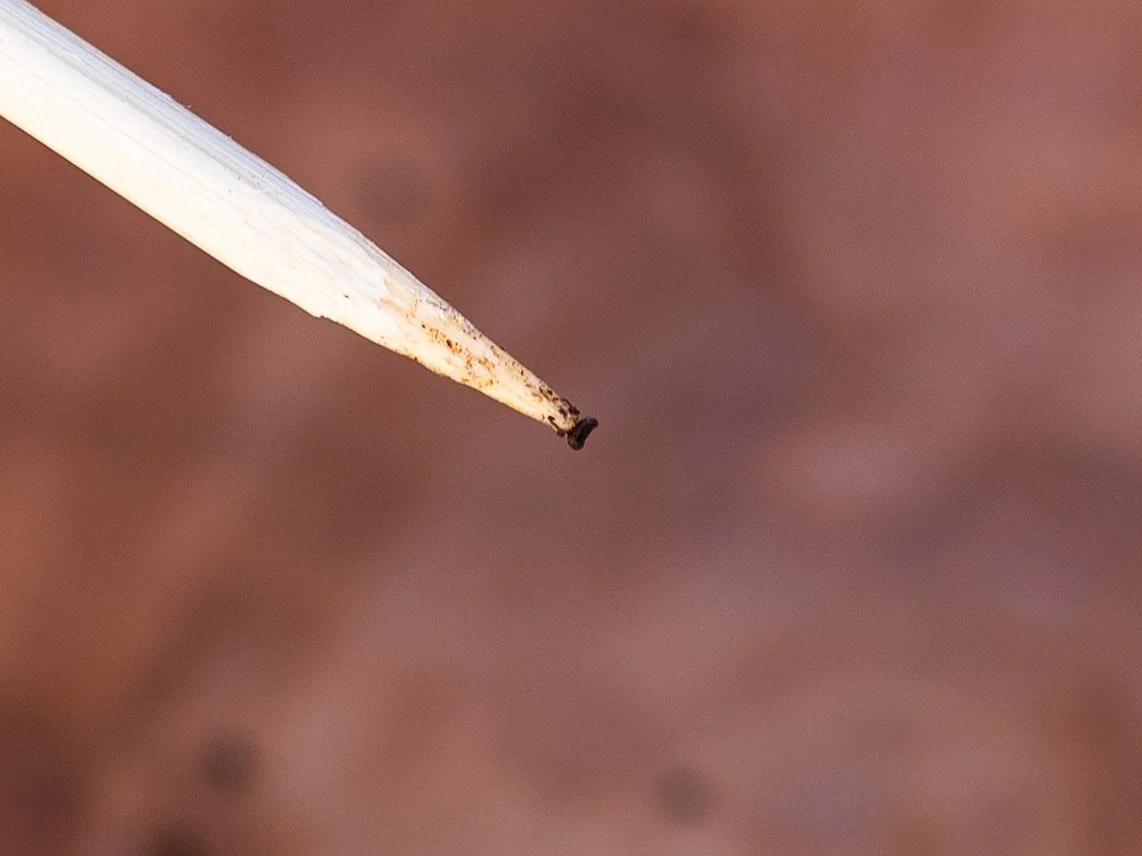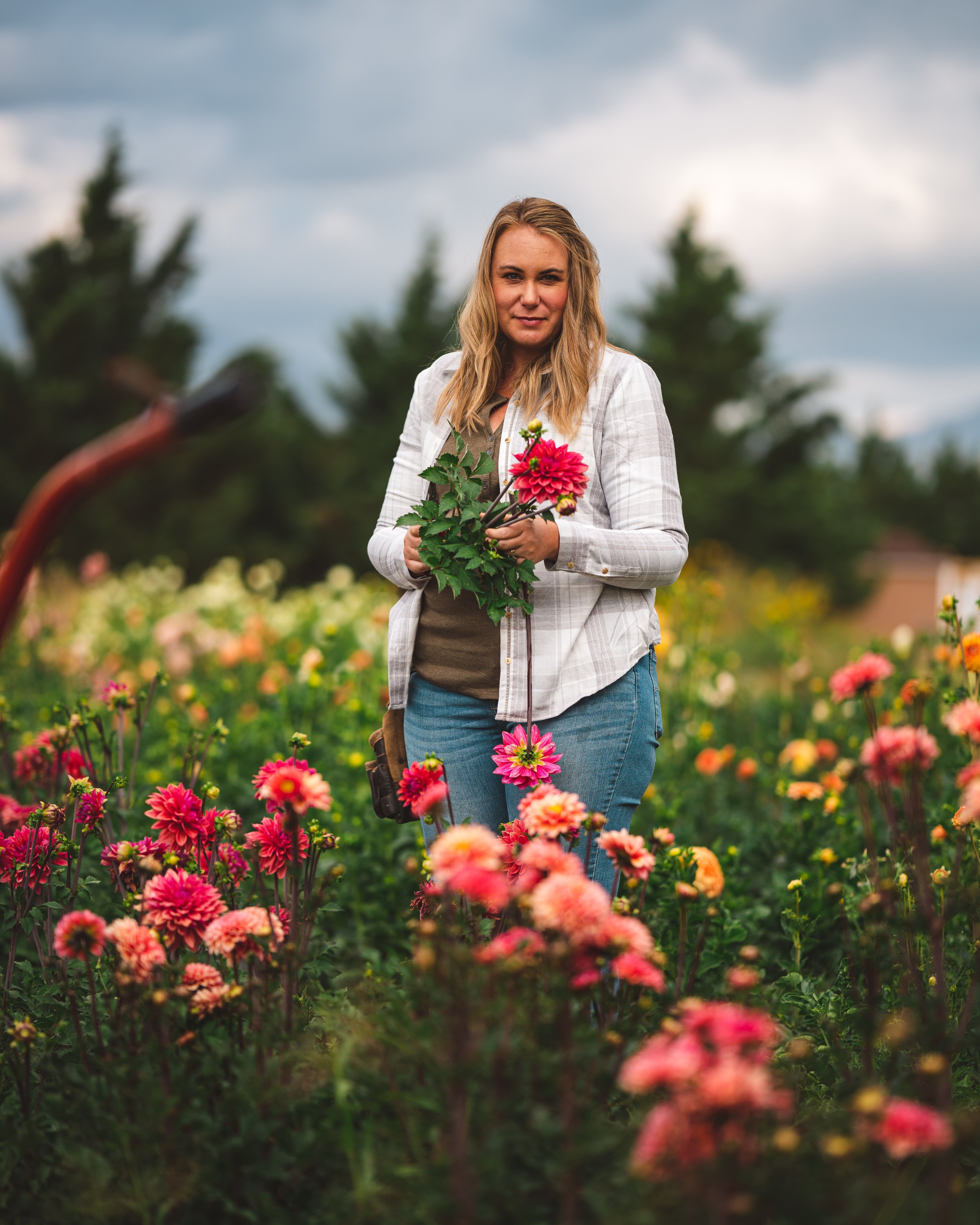Sierra Flower Farm's Must Have Seed Starting Supplies
Disclaimer: This site contains affiliate links to products we wholeheartedly believe in. Your purchases through these links help us bring you more valuable flower-arming content. Thank you for being so supportive!
Over the years, we have hand-sown endless seeds for our cut flower farm. In the early years, we were scrappy. During our first year gardening, I remember spending hours with newspapers we snagged from friends and family and with an old olive oil bottle and some scotch tape to make pots for starting seeds. I sat under the overhang of our back porch, rolling and taping while Emma twirled, singing, and Janey “drew” on the cement with an overly long stick and the water from the dog bowl.
This route was endearing and fun when gardening was a hobby but time-consuming.
Fast forward over eight years later, we have had various trials and errors of which seed-starting products work, break down, increase our efficiency, and improve the quality of our product.
Today, I wanted to share some of our must-have seed-starting products and suppliers we currently use!
Our criteria:
Sturdy
We are rough on our trays, and they need to withstand everyday use under harsh conditions without breaking.
Increase efficiency
Time is money, and the increase in efficiency must offset the cost of the product.
Aides in healthy seedlings
We rely on healthy, happy, stout seedlings that thrive without a hiccup once planted in the field.
Quality
Quality products that aren’t going to deteriorate within a growing season, ideally not for many to come!
Quality seeds, corms, and bulbs that germinate well are disease-free and are true to what they are selling.
Easy to purchase
If I can’t easily purchase an item, I won’t likely proceed with it. I need the purchase process to be easy, convenient, and quick- after all, we have kids and two businesses to run.
First, let’s start with our favorite suppliers for seeds and corms!
Seed, Corm, Bulbs & Tuber Suppliers
If finding a company to entrust your hard-earned money isn’t enough, let’s throw in entrusting your entire flower farm’s growing season to them. Initially, we invested in retail seed packets and emptied Costco’s clearance shelf to snag ranunculus corms and tulip bulbs. The retail packets cost us more than had we sourced seeds from a company that sells to commercial growers. The clearance rack corms and bulbs were not the best. By that summer, I realized I wanted to invest in more premium varieties and high-quality products.
The difference was night and day!
The plants grew more robust; the stems were long and sturdy, and the flowers beautiful and plenty. See, part of the challenge when purchasing retail is not only are you getting small quantities, but you are also getting products that are meant more for landscape, sure they can be usable, but not ideal.
As a small business, we also like to support companies that are smaller and who greatly help us in our growing endeavor!
Here are our leading go-to suppliers:
Johnny Selected Seeds
I have been a huge fan of Johnny’s for years, employee-owned, and they don’t allow their catalog to go stale, as they typically release new varieties each fall. I appreciate their user-friendly website, and they have a wealth of information filled with tons of free resources for market growers specializing in vegetables and specialty cut flowers.
Onings America/Italian Ranunculus
I’m often asked where I source:
Ranunculus & Anemone corms
Spring Bulbs such as tulips, narcissi, fritillaria
Peony bare roots
Colibri poppies
and the answer is Onings!
Their ordering process is a bit of a hybrid mix of the new school and old school, but their customer service is terrific, and they are quick to respond, which has bailed me out a time or two while I stood over a sad crop!
In the past, I used various other suppliers, but over the years, those suppliers would let me down in quality and disease, or they would cancel my order last minute; I have not had that same experience using Onings.
To get a listing of their current availability and to order, click the button below to reach out to them; they prefer Instagram for initial communications. Tell them Sierra Flower Farm recommended you to them!
Small-Scale Seed Suppliers
For most of our seed and corm needs, we are pretty set between Johnny Selected Seeds and Onings, though sometimes we are looking for the specialty of the specialty cut flowers, which is where the small-scale seed suppliers come in.
We have increasingly supported small-scale breeders and seed suppliers in the last few years to bring more desirable and exciting varieties, especially for our wedding designs. Supporting small-scale seed suppliers doesn’t always mean hefty price tags, though it can mean that they are expensive, especially for the varieties that are brand new to the market. When deciding whether or not to invest in the more expensive, more unique varieties, consider your product offerings and whether they can absorb the extra cost.
For us, especially sweet peas, I like to source from smaller breeders since they often have the quality seeds and varieties I am interested in growing. In the past, we purchased all our sweet peas from a supplier in the UK until customs became too much of a battle, and we lost out on hundreds of dollars and no sweet pea seeds. Last season, our entire sweet pea crop came from Floret Flower Farm and Ardelia Farm’s sweet peas, and we had some of the best sweet peas ever! With Floret Flower Farm no longer offering sweet peas and Ardelia Farm taking the season off, I was greatly relieved to find some other smaller growers to be able to purchase from here in the U.S., especially one of my current favorite sweet peas, Aloysius Dickinson.
Up & Coming Small-Scale Breeders
Check out our blog about Blomma Flower Farm and visit our Instagram to learn how to enter to win a packet of Blomma’s Zinnias!
Sweet Peas
Sunflowers
The list can keep growing! I have enjoyed Floret Flower Farm’s Favorite Specialty Seed Sources to continue searching for unique specialty seed suppliers.
If you want to learn more about seed starting, you can read our blog here.
If you are having a rocky start in germination or have other seed-starting woes, you can read our blog on troubleshooting seed germination here.
Throughout this next section, you will see many recommendations for Bootstrap Farmer. We have personally used each item listed and found them to be high-quality products. Most of their products are made in Texas in the United States and shipped internationally. They are a smaller company, bringing quality products and innovation to small-scale growers. Much like the small-scale breeders, I am excited to see what Bootstrap Farmer has in store for our industry!
In our first year of flower farming, we invested in soil blockers; next are our favorite soil-blocking supplies!
Soil Blocking
At the beginning of our soil-blocking endeavor, we did what we could to make them work within our budget. For trays, we used dollar store cookie sheets; we have also experimented using cafeteria trays. Honestly, it worked, but I did not love them. The soil block on the cookie sheets dried out too quickly, and the cafeteria trays were funky dimensions, which made it so we weren’t optimizing our limited space in the greenhouse.
This year, we upgraded our soil-blocking gear and have fallen in love with it again!
Soil blocking is a great alternative to propagation cell trays. It can be especially valuable for flower varieties that could benefit from air-pruning to keep them from getting rootbound.
Mini Soil Blocks
Some of our favorite varieties to soil block in the 3/4” mini soil blocks:
Larkspur
Poppies
Agrostemma
Lisianthus
Celosia
Ornamental grasses
Snapdragons
Foxglove
Annual Phlox
Nigella
Bachelor Buttons
Stock
Bootstrap Farmer has sturdy mesh trays, which are not only great for drying freshly divided dahlia tubers but are fantastic for soil blocks. We prefer to use the 1020 shallow mesh trays paired with the shallow flood tray for the mini 3/4” soil blocks, which comfortably fit 200 soil blocks.
2 Inch Soil Blocks
For the 2” soil blocks, the 1020 deep mesh tray with the deep flood tray is excellent because the trays are strong and can easily handle the weight of the soil blocks. Since I often carry multiple trays at once, their rigidness is a big deal.
Some of our favorite varieties to soil block in the 2” soil blocks:
Zinnias
Cosmos
Ammi
Marigolds
Lupine
Currant tomatoes
Amaranth
Orlaya
Honeywort
The great part about the mesh trays is that they are stout. Coupled with the flood trays, they make bottom watering the soil blocks incredibly efficient since overhead watering detoriates the soil blocks.
Bootstrap Farmer’s Soil Block Drop Seeder
Another product we have been experimenting with is Bootstrap Farmer’s mini soil blocker seeder and plates. We are still testing which size plates to use with which seed, but we love being able to dump the seed, roll it, and then drop it perfectly centered in the soil block. Soil blocking is lovely but can be a bit more time-consuming; having a seeder for the soil blocks can help increase efficiency. However, we quickly discovered that pelleted seeds are challenging to use because of static electricity; this may be unique to our arid climate, where the dry air creates quite a bit of static electricity, especially in the winter months.
To learn more about soil blocking, you can read our blog on that topic here.
Soil blocking Alternatives
Sometimes, soil blocking isn’t the ideal technique for starting select crops, but the plant can greatly benefit from air-pruning. Fortunately, there are some great alternatives available with air-pruning technology!
Bootstrap Farmer’s Air-Prune Trays
As an alternative, we have also been loving using Bootstrap Farmer’s 72-cell air-pruning trays for varieties where we want the benefit of soil blocking but need the rigidness of a tray. They are fast, easy to use, and great for corms. We love that we can stack the trays as usual but with the added benefit of the increased airflow and air pruning to keep the corms’ roots happy and healthy. The shallow flood trays also make bottom watering convenient.
Along with ranunculus and anemone corms, the same crops we have found to benefit from the 2” soil blocks could easily transition to the 72-cell air prune trays instead.
For sweet peas, I have been hunting for better trays than what we have been using. We were given seedling propagation trays that had been used to propagate berries, and though rigid, getting the seedlings out at planting time took more time and effort. Sweet peas have an extremely fast-growing taproot, and they quickly outgrow the soil block and the next size we find to be too large, which is why we were excited to see the Goldilocks of air pruning in a deep enough cell with Bootstrap Farmer’s four cell plug insert that we used in conjunction with the deep flood tray to water.
Along with starting sweet peas, I have also been using them to winter over heirloom mums, sedum, and scented geraniums, from which I take cuttings.
Propagation Cell Trays
In a rush, we find ourselves grabbing for the convenience of a traditional propagation tray. They are also easy enough that our children can help fill and sow trays, which is nice since they aren’t quite strong enough for the soil blocks yet. Until last year, though, we were ready to abandon the propagation trays. We are tired of having to reinvest in trays each year since they break down and deteriorate quickly. I can’t begin to tell you how many times one of us lost half a tray of seedlings due to the tray breaking in half as we walked from the greenhouse to the field at planting.
Finally, we decided to bite the bullet and try Bootstrap Farmer’s propagation trays, and I have been a huge fan ever since! Looking at the numbers, even though they were initially an investment, they are in year two and do not show any wear. We are not the kindest to our trays, and we need them to be able to handle the abuse, which they do.
We will share which crops we prefer to start in which cell-sized trays.
200 Cell Propagation Trays
We like these ones for the smaller, slower-growing crops that could use the smaller amount of soil to warm more efficiently. Using such small cell sized trays does require being watchful, as they dry out quickly.
Lisianthus
Snapdragons
Foxglove
Iceland Poppies
Violas
128 Cell Propagation Trays
These trays are the ones we use to start a majority of our seeds, along with bumping up the varieties from the 200-cell propagation trays.
Ornamental Cabbage/Kale
Ornamental Grasses
Amaranth
Dusty Miller
Yarrow
Agrostemma
Bells of Ireland
Campanula
Cress
Feverfew
Carnations
Eucalyptus
Godetia
Gomphrena
Larkspur
Strawflower
72 and 50 Cell Propagation Trays
We use these sized trays fairly interchangeably, and honestly, it comes down to how much space we have in the greenhouse and how the weather is going. These are the propagation crops with larger seeds cell trays that we will use for faster-growing.
Calendula
Zinnias
Marigolds
Cosmos
Ornamental Corn
Ornamental Squash
Honeywort
Ammi
No matter which propagation trays we use, we use them with deep flood trays for bottom watering.
More Products We Use for Seed Starting
We need more than seeds and trays; here are some other products we use for seed starting!
Bamboo Skewers
Bamboo skewers may seem odd for seed starting, but I love them for sowing tiny seeds. With a small jar of water, a dish holding the seeds, and two bamboo skewers, I’m ready to tackle all those snapdragon seeds! I use one bamboo skewer for sowing the seeds and the other to help guide me down the tray so I don’t lose my place. Bamboo skewers are an inexpensive tool that can easily be found in any grocery store.
Watering Can
Besides soil blocks, I often overhead water freshly sown trays, especially in the beginning. Many of the more standard watering cans do not produce a soft water flow, so I appreciate the Dramm 5-liter watering can that is specially designed to be gentle enough to use on seedlings.
Sometimes, you can find the Dramm watering can at garden centers, and they also offer Johnny Selected Seeds. Keep the watering can out of the sun since it will break down the plastic.
Fertilizers
Over or under-fertilizing can be a real struggle regarding seedlings. We have found the FoxFarm Big Bloom to be gentler on the younger seedlings, and then we follow up with Grow Big when the seedling is actively growing. Using the directions on the bottle, we have not had these fertilizers burn the tender seedlings; they seem more forgiving than fish emulsion (and less smelly!).
We drench the seedlings weekly. Be sure to do it when they are hydrated and not in full sun. You can also bottom-water-fertilize the seedlings using a flood tray, which we often do.
We bootstrapped our seed starting supplies and processes for many years, but as time became less and the business earned more, we needed to reevaluate. You may face the dilemma of balancing DIY paper pots or investing in trays or soil blockers. Hopefully, this post answered some questions and gave you some insight.
If you have any questions or products you love and would like to add, do so in the comment section below!
Until next time, we are looking forward to helping you hand blooms soon!
- Jessica & Graham


















